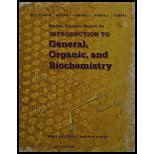
(a)
Interpretation:
To justify whether the given statement is true or false.
Concept Introduction:
The phases, solid, liquid or gas, are interconvertible from one to another by addition or removal of energy.
(b)
Interpretation:
To justify whether the given statement is true or false.
Concept Introduction:
Density of any substance is a ratio of its mass and volume. It gives information about the degree of compactness of a substance.
(c)
Interpretation:
To justify whether the given statement is true or false.
Concept Introduction:
The solid phase of a substance has definite shape and volume as the intermolecular force of attraction between the atom/ions or molecules are very strong.
(d)
Interpretation:
To justify whether the given statement is true or false.
Concept Introduction:
Matter or element or substances which are surrounded around us are having three basic forms-
(e)
Interpretation:
To justify whether the given statement is true or false.
Concept Introduction:
Crystallization is a process in which liquid is cooled to particular temperature to form a solid form of it. Carbon has five allotropes which are having different chemical and physical properties.
(f)
Interpretation:
To justify whether the given statement is true or false.
Concept Introduction:
Crystalline form of carbon like diamond, graphite, buckyball, nanotube and soot are having different arrangements of carbon atom in it. Depends upon the arrangements of carbon atoms, this crystalline form is differentiated.
(g)
Interpretation:
To justify whether the given statement is true or false.
Concept Introduction:
An arithmetical multiplier which is used for converting a quantity expressed in one unit into another equivalent set of units is said to be conversion factor.
(h)
Interpretation:
To justify whether the given statement is true or false.
Concept Introduction:
Carbon nanotubes are allotropes of carbon whose structure is cylindrical nanostructure.
(i)
Interpretation:
To justify whether the given statement is true or false.
Concept Introduction:
Carbon has five allotropes which are having different chemical and physical properties. Examples are diamond, graphite, soot, nanotubes and buckyball.
(j)
Interpretation:
To justify whether the given statement is true or false.
Concept Introduction:
The process in which the substance changes from a solid phase to liquid phase is said to be the melting of solid.
(k)
Interpretation:
To justify whether the given statement is true or false.
Concept Introduction:
Solids that do not have definite geometrical shape are said to be amorphous in nature, they do not have sharp melting point and lack in long-range order.
Want to see the full answer?
Check out a sample textbook solution
Chapter 5 Solutions
Student Solutions Manual for Bettelheim/Brown/Campbell/Farrell/Torres' Introduction to General, Organic and Biochemistry, 11th
- A mixture of C7H12O2, C9H9OCl, biphenyl and acetone was put together in a gas chromatography tube. Please decide from the GC resutls which correspond to the peak for C7,C9 and biphenyl and explain the reasoning based on GC results. Eliminate unnecessary peaks from Gas Chromatography results.arrow_forwardIs the molecule chiral, meso, or achiral? CI .CH3 H₂C CIarrow_forwardPLEASE HELP ! URGENT!arrow_forward
- Identify priority of the substituents: CH3arrow_forwardHow many chiral carbons are in the molecule? OH F CI Brarrow_forwardA mixture of three compounds Phen-A, Acet-B and Rin-C was analyzed using TLC with 1:9 ethanol: hexane as the mobile phase. The TLC plate showed three spots of R, 0.1 and 0.2 and 0.3. Which of the three compounds (Phen-A; Acet-B or Rin-C) would have the highest (Blank 1), middle (Blank 2) and lowest (Blank 3) spot respectively? 0 CH: 0 CH, 0 H.C OH H.CN OH Acet-B Rin-C phen-A A A <arrow_forward
 Introduction to General, Organic and BiochemistryChemistryISBN:9781285869759Author:Frederick A. Bettelheim, William H. Brown, Mary K. Campbell, Shawn O. Farrell, Omar TorresPublisher:Cengage Learning
Introduction to General, Organic and BiochemistryChemistryISBN:9781285869759Author:Frederick A. Bettelheim, William H. Brown, Mary K. Campbell, Shawn O. Farrell, Omar TorresPublisher:Cengage Learning Chemistry by OpenStax (2015-05-04)ChemistryISBN:9781938168390Author:Klaus Theopold, Richard H Langley, Paul Flowers, William R. Robinson, Mark BlaserPublisher:OpenStax
Chemistry by OpenStax (2015-05-04)ChemistryISBN:9781938168390Author:Klaus Theopold, Richard H Langley, Paul Flowers, William R. Robinson, Mark BlaserPublisher:OpenStax Introductory Chemistry: A FoundationChemistryISBN:9781337399425Author:Steven S. Zumdahl, Donald J. DeCostePublisher:Cengage Learning
Introductory Chemistry: A FoundationChemistryISBN:9781337399425Author:Steven S. Zumdahl, Donald J. DeCostePublisher:Cengage Learning Chemistry for Engineering StudentsChemistryISBN:9781337398909Author:Lawrence S. Brown, Tom HolmePublisher:Cengage Learning
Chemistry for Engineering StudentsChemistryISBN:9781337398909Author:Lawrence S. Brown, Tom HolmePublisher:Cengage Learning



